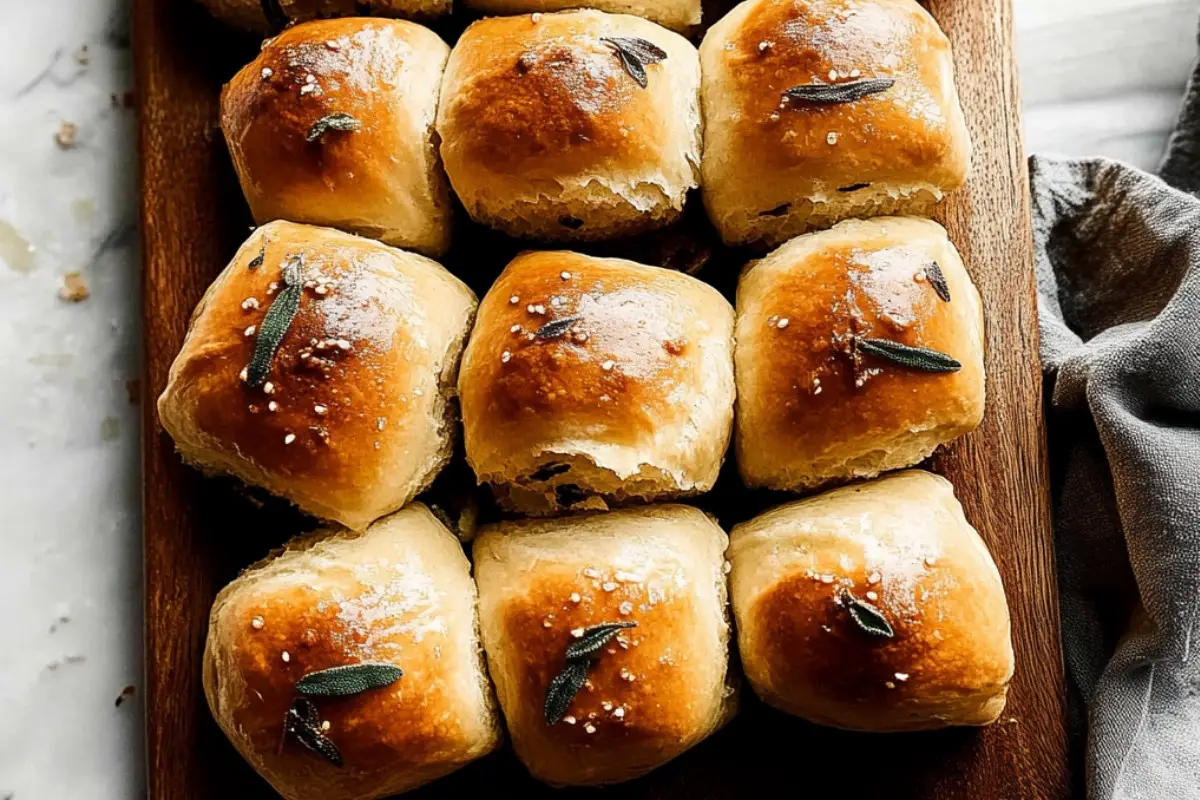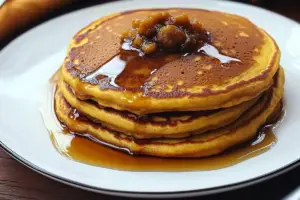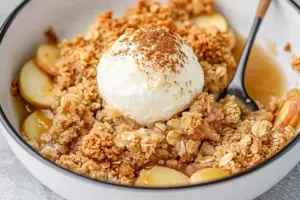Introduction
Upgrade your dinner table with these irresistible Brown Butter & Sage Dinner Rolls, a perfect blend of nutty, aromatic brown butter and fragrant sage. These rolls are not just your average dinner side; they are a culinary delight that promises melt-in-your-mouth goodness and a touch of gourmet flair. Ideal for special occasions, yet easy enough to whip up any day of the week, these rolls will quickly become a beloved staple. Savor the rich flavors that will remind you why baking from scratch is truly worth every moment.
Detailed Ingredients
Unsalted butter (1/2 cup): Provides a rich, creamy base that becomes the aromatic brown butter.
Fresh sage (1 tablespoon finely chopped): Offers a fragrant herbal note, enhancing the depth of flavor.
Whole milk (3/4 cup): Complements the dough’s texture, adding richness and moisture.
Granulated sugar (2 tablespoons): Adds a touch of sweetness, promoting yeast growth for a good rise.
Active dry yeast (2 1/4 teaspoons): Essential for the dough’s rise, giving the rolls their light, fluffy texture.
All-purpose flour (3 cups): The foundation of the rolls, forming the dough’s structure.
Salt (1 teaspoon): Enhances the overall flavor, balancing sweetness and emphasizing savory elements.
Large egg (1): Contributes to the structure and adds richness and color to the rolls.
- Prep Time: 30 minutes
- Cook Time: 25 minutes
- Total Time: 2 hours 30 minutes
- Yield: 12 rolls
Detailed Directions and Instructions
Step 1: Prepare the Brown Butter
Begin by melting the unsalted butter in a saucepan over medium heat. Watch closely as it turns golden brown, releasing a nutty aroma. Once browned, quickly stir in the finely chopped fresh sage to infuse the butter with its fragrant notes. Remove the saucepan from the heat and let the mixture cool slightly.
Step 2: Prepare the Milk and Yeast Mixture
In a small saucepan, heat the whole milk just until it becomes lukewarm. Be careful not to overheat. Remove the saucepan from the burner, stir in the granulated sugar, and sprinkle the active dry yeast on top. Allow it to stand without stirring for 5-10 minutes until the mixture becomes frothy, indicating that the yeast is activated.
Step 3: Mix the Dough
In a large mixing bowl, combine the all-purpose flour and salt. Form a well in the center and pour in the lukewarm brown butter and sage mixture, the whisked large egg, and the yeast mixture. Stir together with a wooden spoon or spatula until a dough begins to form.
Step 4: Knead the Dough
Lightly flour a clean work surface and transfer the dough onto it. Knead the dough with your hands for about 5 minutes, until it becomes smooth and elastic. Add more flour as necessary, a tablespoon at a time, if the dough seems too sticky.
Step 5: Allow the Dough to Rise
Transfer the kneaded dough into a lightly greased large bowl, rolling the dough around to coat it in oil. Cover the bowl with a clean damp kitchen towel or plastic wrap, and allow the dough to rise in a warm, draft-free area until doubled in size. This should take about 1-2 hours.
Step 6: Shape the Rolls
Punch down the dough to release the gases and divide it into 12 equal portions. Shape each piece into a smooth roll by tucking the dough underneath itself. Place the rolls onto a greased baking dish, spaced slightly apart.
Step 7: Second Rise
Cover the baking dish with a damp kitchen towel or plastic wrap and let the rolls rise again for 30-45 minutes, or until they have doubled in size and are puffy.
Step 8: Bake the Rolls
Preheat your oven to 350°F (177°C). Once preheated, place the baking dish in the oven and bake the rolls for 20-25 minutes, or until they are golden brown on top and sound hollow when tapped.
Step 9: Serve and Enjoy
Remove the rolls from the oven and let them cool slightly in the dish for a few minutes. Serve these heavenly rolls warm for the best experience, savoring their buttery, sage-infused flavor.
Notes
Sage Selection
Choose fresh sage for the most aromatic experience. Dried sage can be used in a pinch, but begin with less as its flavor is more concentrated. The fresh sage offers a vibrant green hue and a complex aroma that complements the nutty brown butter beautifully.
Yeast Activation
Ensure your yeast is fresh by checking the expiration date. Alternatively, test it by mixing it in warm water with sugar; if it doesn’t foam after 10 minutes, it may be inactive and should be replaced. Active dry yeast plays a crucial role in achieving the light, airy texture of these dinner rolls.
Temperature Control
Monitor the temperature of the milk closely; if it’s too hot, it can kill the yeast, preventing the dough from rising. Lukewarm, or akin to body temperature, is ideal. A kitchen thermometer can ensure you’re within the perfect range.
Kneading Technique
Kneading is vital for developing gluten in the dough, which gives the rolls their structure. Use a gentle yet firm hand motion, folding the dough and pressing it down, turning it 90 degrees each time. This ensures even gluten development for a smooth, elastic dough.
Storage and Reheating
Store any leftover rolls in an airtight container at room temperature for up to two days for optimal freshness. For longer storage, freeze the rolls, then reheat when needed. To refresh, simply warm them in an oven preheated to 300°F (150°C) until heated through.
Cook Techniques
Browning Butter
The technique of browning butter adds a new dimension of flavor, enriching the rolls with its nutty profile. Ensure constant stirring during browning to avoid burning and achieve the desired golden hue.
Kneading Dough
The kneading process is fundamental in developing gluten, which provides elasticity and structure. For optimal results, knead until the dough becomes soft, smooth, and slightly tacky to the touch.
Proofing Dough
Allowing the dough to rise until doubled is critical for light rolls. This process, known as proofing, activates the yeast and creates air pockets within the dough, making the rolls fluffy.
Shaping Rolls
For uniform rolls, use a kitchen scale to divide the dough into equal portions. Roll each one gently against your palm to create a smooth, taut surface, encouraging even baking and a satisfying texture.
Cooling and Serving
Let the rolls cool slightly before serving to allow flavors to meld and textures to set, ensuring a delightful experience. Serve warm to elevate the aromatic sage and brown butter notes.
Five Paragraphs Related
These Brown Butter & Sage Dinner Rolls embody a perfect balance of savory and sweet, making them an ideal accompaniment to soups, stews, or any hearty main dish. The nutty richness of browned butter combined with the earthy fragrance of sage crafts a unique flavor profile that complements both traditional and contemporary dishes. Whether hosting a dinner party or enjoying a quiet meal at home, these rolls enhance any dining experience with their gourmet flair.
Baking from scratch has a special charm, inviting not only delicious homemade flavor but also the joy of creativity and hands-on expression. The process of crafting these rolls–from browning the butter to kneading the dough and watching it rise–offers a rewarding kitchen experience. As you experiment with herbs and techniques, each batch of rolls can become a canvas for culinary exploration and personal adaptation.
Incorporating herbs like sage in your baking not only amplifies flavor but also brings a touch of elegance to the table. Sage, known for its aromatic qualities and complexity, pairs beautifully with the nuttiness of brown butter. This combination transforms a simple dinner roll into a foolproof crowd-pleaser capable of making any meal memorable and delightful.
In the realm of bread baking, texture is as crucial as flavor. Achieving that perfect balance of a crisp, golden exterior with a soft, tender interior is an art. These dinner rolls master this balance, thanks to the thorough kneading and proofing processes that ensure proper gluten development and yeast activation. Once baked, they offer a pleasant contrast with every bite.
Sustainability in the kitchen can start with simple actions like baking your own bread. Not only does it cut down on packaging waste associated with store-bought options, but it also allows you the control to source quality ingredients. By baking these flavorful rolls, you’re not only enriching your meals but also taking a step towards a more mindful and eco-friendly cooking practice.
Tips
To enhance the flavor of your Brown Butter & Sage Dinner Rolls, consider adding a sprinkle of flaky sea salt to the top of the rolls just before baking. This touch of seasoning highlights the buttery sage aroma and adds a delightful burst of flavor. For an extra indulgence, brush the rolls with a bit more melted butter right out of the oven.
FAQ
Can I use dried sage instead of fresh?
Yes, you can substitute dried sage for fresh in this recipe. However, since dried sage has a more concentrated flavor, start by using half the amount and adjust according to your taste preference.
What can I do if my dough isn’t rising?
If your dough isn’t rising, the yeast might be inactive. Ensure your yeast isn’t expired and that your milk mixture wasn’t too hot. You can also try moving the dough to a warmer spot, as a comfortable room temperature aids in proper rising.
How should I store leftover rolls?
Store any leftover rolls in an airtight container at room temperature for up to two days. For longer storage, freeze the rolls for up to one month and reheat them in the oven before serving to refresh their texture.
Can I make these rolls ahead of time?
Yes, you can prepare the dough the night before. Allow it to rise in the refrigerator overnight, then proceed with shaping and baking the rolls the next day. Letting the dough rise slowly in the fridge can also enhance the flavor.
What should I serve with these dinner rolls?
These rolls pair excellently with hearty dishes like soups, stews, or roasted meats. They also make a delicious snack served with a flavored butter or a dip of your choice.
Can I make these rolls vegan?
To make these rolls vegan, substitute the butter with a plant-based alternative and replace the egg with a flaxseed or chia seed egg substitute. Ensure the milk is swapped for a non-dairy option such as almond or soy milk.
Conclusion
Brown Butter & Sage Dinner Rolls are more than just a side dish; they are an indulgence that enriches any meal with their unique blend of flavors and aromatic allure. With their delightful balance of taste and texture, these rolls serve as a testament to the joys of baking and the wonders of homemade simplicity. Perfect for special occasions or an everyday treat, they are sure to leave a lasting impression on anyone who takes a bite.
More Recipes Suggestions and Combination
Garlic and Herb Focaccia
If you’ve enjoyed baking Brown Butter & Sage Dinner Rolls, why not try your hand at a flavorful focaccia? Infused with the rich scent of garlic and your choice of herbs, this bread is perfect for dipping in olive oil or as a base for gourmet sandwiches.
Rosemary and Olive Oil Ciabatta
For those who appreciate herbaceous flavors, Rosemary and Olive Oil Ciabatta is an excellent choice. The soft chewiness of ciabatta combined with the aromatic rosemary creates a perfect bread for pairing with meats and cheeses.
Cheddar and Jalapeño Cornbread
Brighten up your bread selection with Cheddar and Jalapeño Cornbread. The spicy kick of jalapeño paired with the creamy goodness of cheddar offers a delightful contrast that pairs well with chili or barbecue.
Honey Butter Biscuits
If you’re looking for a sweet and savory combination, Honey Butter Biscuits offer a delectable alternative. Biscuits topped with homemade honey butter bring a touch of sweetness, which complements savory dishes impressively well.
Parmesan and Black Pepper Breadsticks
Parmesan and Black Pepper Breadsticks offer a crisp, flavorful alternative for dinner rolls. Simple to make, these breadsticks are perfect for dipping into soups or as a snack with marinara sauce.
PrintBrown Butter & Sage Dinner Rolls
Upgrade your dinner table with these irresistible Brown Butter & Sage Dinner Rolls, a perfect blend of nutty, aromatic brown butter and fragrant sage. These rolls are not just your average dinner side; they are a culinary delight that promises melt-in-your-mouth goodness and a touch of gourmet flair. Ideal for special occasions, yet easy enough to whip up any day of the week, these rolls will quickly become a beloved staple. Savor the rich flavors that will remind you why baking from scratch is truly worth every moment.
- Prep Time: 30 minutes
- Cook Time: 25 minutes
- Total Time: 2 hours 30 minutes
- Yield: 12 rolls
Ingredients
Unsalted butter (1/2 cup): Provides a rich, creamy base that becomes the aromatic brown butter.
Fresh sage (1 tablespoon finely chopped): Offers a fragrant herbal note, enhancing the depth of flavor.
Whole milk (3/4 cup): Complements the dough’s texture, adding richness and moisture.
Granulated sugar (2 tablespoons): Adds a touch of sweetness, promoting yeast growth for a good rise.
Active dry yeast (2 1/4 teaspoons): Essential for the dough’s rise, giving the rolls their light, fluffy texture.
All-purpose flour (3 cups): The foundation of the rolls, forming the dough’s structure.
Salt (1 teaspoon): Enhances the overall flavor, balancing sweetness and emphasizing savory elements.
Large egg (1): Contributes to the structure and adds richness and color to the rolls.
Instructions
Step 1: Prepare the Brown Butter
Begin by melting the unsalted butter in a saucepan over medium heat. Watch closely as it turns golden brown, releasing a nutty aroma. Once browned, quickly stir in the finely chopped fresh sage to infuse the butter with its fragrant notes. Remove the saucepan from the heat and let the mixture cool slightly.
Step 2: Prepare the Milk and Yeast Mixture
In a small saucepan, heat the whole milk just until it becomes lukewarm. Be careful not to overheat. Remove the saucepan from the burner, stir in the granulated sugar, and sprinkle the active dry yeast on top. Allow it to stand without stirring for 5-10 minutes until the mixture becomes frothy, indicating that the yeast is activated.
Step 3: Mix the Dough
In a large mixing bowl, combine the all-purpose flour and salt. Form a well in the center and pour in the lukewarm brown butter and sage mixture, the whisked large egg, and the yeast mixture. Stir together with a wooden spoon or spatula until a dough begins to form.
Step 4: Knead the Dough
Lightly flour a clean work surface and transfer the dough onto it. Knead the dough with your hands for about 5 minutes, until it becomes smooth and elastic. Add more flour as necessary, a tablespoon at a time, if the dough seems too sticky.
Step 5: Allow the Dough to Rise
Transfer the kneaded dough into a lightly greased large bowl, rolling the dough around to coat it in oil. Cover the bowl with a clean damp kitchen towel or plastic wrap, and allow the dough to rise in a warm, draft-free area until doubled in size. This should take about 1-2 hours.
Step 6: Shape the Rolls
Punch down the dough to release the gases and divide it into 12 equal portions. Shape each piece into a smooth roll by tucking the dough underneath itself. Place the rolls onto a greased baking dish, spaced slightly apart.
Step 7: Second Rise
Cover the baking dish with a damp kitchen towel or plastic wrap and let the rolls rise again for 30-45 minutes, or until they have doubled in size and are puffy.
Step 8: Bake the Rolls
Preheat your oven to 350°F (177°C). Once preheated, place the baking dish in the oven and bake the rolls for 20-25 minutes, or until they are golden brown on top and sound hollow when tapped.
Step 9: Serve and Enjoy
Remove the rolls from the oven and let them cool slightly in the dish for a few minutes. Serve these heavenly rolls warm for the best experience, savoring their buttery, sage-infused flavor.
Notes
Sage Selection
Choose fresh sage for the most aromatic experience. Dried sage can be used in a pinch, but begin with less as its flavor is more concentrated. The fresh sage offers a vibrant green hue and a complex aroma that complements the nutty brown butter beautifully.
Yeast Activation
Ensure your yeast is fresh by checking the expiration date. Alternatively, test it by mixing it in warm water with sugar; if it doesn’t foam after 10 minutes, it may be inactive and should be replaced. Active dry yeast plays a crucial role in achieving the light, airy texture of these dinner rolls.
Temperature Control
Monitor the temperature of the milk closely; if it’s too hot, it can kill the yeast, preventing the dough from rising. Lukewarm, or akin to body temperature, is ideal. A kitchen thermometer can ensure you’re within the perfect range.
Kneading Technique
Kneading is vital for developing gluten in the dough, which gives the rolls their structure. Use a gentle yet firm hand motion, folding the dough and pressing it down, turning it 90 degrees each time. This ensures even gluten development for a smooth, elastic dough.
Storage and Reheating
Store any leftover rolls in an airtight container at room temperature for up to two days for optimal freshness. For longer storage, freeze the rolls, then reheat when needed. To refresh, simply warm them in an oven preheated to 300°F (150°C) until heated through.












